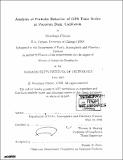| dc.contributor.advisor | Thomas A. Herring. | en_US |
| dc.contributor.author | Piboon, Monchaya, 1976- | en_US |
| dc.contributor.other | Massachusetts Institute of Technology. Dept. of Earth, Atmospheric, and Planetary Sciences. | en_US |
| dc.coverage.spatial | n-us-ca | en_US |
| dc.date.accessioned | 2010-05-25T20:37:41Z | |
| dc.date.available | 2010-05-25T20:37:41Z | |
| dc.date.copyright | 2002 | en_US |
| dc.date.issued | 2002 | en_US |
| dc.identifier.uri | http://hdl.handle.net/1721.1/55067 | |
| dc.description | Thesis (S.M.)--Massachusetts Institute of Technology, Dept. of Earth, Atmospheric, and Planetary Sciences, 2002. | en_US |
| dc.description | Includes bibliographical references (leaves 67-68). | en_US |
| dc.description.abstract | High precision GPS receiver can yield position measurements within millimeter level accuracy. This accuracy provides an opportunity to observe subtle changes such as crustal movements. In addition,it allows the monitoring of large structures such as dams for safety reason. A GPS system was installed at Pacoima Dam in order to monitor potential instability. The GPS system consists of 2 receivers, DAMI and DAM2, which are part of GPS network in Southern California. The displacement derived from the GPS receivers indicated that the dam's arch moves periodically with an annual period. Because of the annual period of the time series, we investigated if the movement of the dam arch could be due to thermoelastic deformation. An estimation of the dam arch displacement change based on thermoelastic deformation theory is derived. To analyze the observables, we performed spectral analysis between the GPS displacements and the temperature variation. The spectral analysis results is in agreement with the magnitude derived from thermoelasticity theory. The results show that Pacoima Dam's displacement is consistent with thermoelastic deformation. The water loading however may also have contribution to the movement of the dam. | en_US |
| dc.description.statementofresponsibility | by Monchaya Piboon. | en_US |
| dc.format.extent | 68 leaves | en_US |
| dc.language.iso | eng | en_US |
| dc.publisher | Massachusetts Institute of Technology | en_US |
| dc.rights | M.I.T. theses are protected by
copyright. They may be viewed from this source for any purpose, but
reproduction or distribution in any format is prohibited without written
permission. See provided URL for inquiries about permission. | en_US |
| dc.rights.uri | http://dspace.mit.edu/handle/1721.1/7582 | en_US |
| dc.subject | Earth, Atmospheric, and Planetary Sciences. | en_US |
| dc.title | Analysis of periodic behavior of GPS time series at Pacoima Dam, California | en_US |
| dc.title.alternative | Analysis of periodic behavior of Global Positioning System time series at Pacoima Dam, California | en_US |
| dc.type | Thesis | en_US |
| dc.description.degree | S.M. | en_US |
| dc.contributor.department | Massachusetts Institute of Technology. Department of Earth, Atmospheric, and Planetary Sciences | |
| dc.identifier.oclc | 51033409 | en_US |
